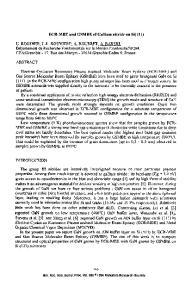Mechanism of Metalorganic MBE Growth of High Quality AIN on Si (111)
- PDF / 378,900 Bytes
- 6 Pages / 612 x 792 pts (letter) Page_size
- 27 Downloads / 355 Views
E3.35.1
Mechanism of Metalorganic MBE Growth of High Quality AlN on Si (111). I. Gherasoiu, S. Nikishin, G. Kipshidze, B. Borisov, A. Chandolu, M. Holtz and H. Temkin Department of Electrical Engineering, Texas Tech University, Lubbock, TX 79409 ABSTRACT AlN constitutes the buffer layer of choice for the growth of GaN on all common substrates and its crystalline quality and surface morphology determine many of the properties of the overgrown epitaxial structure. This work systematically investigates the MOMBE growth of high quality AlN on Si (111) using trimethylaluminum and ammonia as sources of aluminum and nitrogen, respectively. Metalorganic MBE represents a hybrid growth technique that offers a combination of growth precision, in-situ monitoring and ease of source management with the promise of high material quality. We demonstrate very efficient growth, with the growth rate in excess of 500 nm/h and low ammonia consumption of less than 1 sccm. Over the entire domain of growth parameters, the surface roughness remained in the range from 12 to 53 Å rms for AlN layers up to 1000 nm thick. Here, the low values of the roughness are associated to the low growth temperature (760 0C), behavior that contrasts with that usually observed in gas source MBE with elemental Al source. X-ray diffraction linewidth as narrow as 141 arcsec has been demonstrated for samples grown under stoichiometric conditions. High temperature of the ammonia injector promotes the transition to the two-dimensional growth, while reducing the growth rate, pointing out the importance of surface hydrogen. We demonstrate that hydrogen plays an important role in the MOMBE process acting as a surfactant and passivating surface nitrogen bonds. INTRODUCTION The MOMBE technique provides unique advantages for the growth of nitrides, allowing the in situ diagnostics and growth precision required for the processing of advanced devices. Despite such advantages, very little is known about the MOMBE growth of nitrides. This study presents the results of high-quality AlN growth on Si(111), and investigate the phenomena that accompany the growth. EXPERIMENTAL DETAILS Trimethylaluminum (TMAl) and NH3 were used as Al and N sources respectively, to grow AlN on 50 mm diameter Si(111) substrates using a compact MOMBE system. Growth temperatures were in the 760-870oC range and beam equivalent pressures (BEP) of TMAl were varied between 3.8 x 10-6 Torr and 7.5 x 10-6 Torr. Ammonia was introduced in the growth chamber through an injector containing Mo diaphragms heated to temperatures between 150 and 600oC. The growth rate has been monitored using an infrared pyrometer. Surface roughness and crystalline quality were determined by AFM and XRD, respectively.
E3.35.2
GROWTH INITIATION Growth of AlN is initiated after the hydrogen layer at the surface of the Si substrate desorbs. The surface of Si is exposed briefly to TMAl flux at around 700oC. The fluxes of TMAl and ammonia are both admitted in the growth chamber when surface temperature reaches ~780oC. The injector te
Data Loading...










